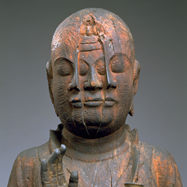Past Exhibitions
- Heian and Kamakura Sculpture from Kyoto
- September 13, 2014 - December 23, 2014
The highlights of this exhibition of Heian (794-1185) and Kamakura (1185-1333) period sculptures are the enormous Seated Dainichi Nyorai and its attendant figure Seated Fudō Myōō from the temple of Kongō-ji in Osaka. The Dainichi Nyorai has relaxed carving of a style favored by the Heian period courtiers. The Fudō Myōō bears a seal of Gyōkai, a leading disciple of the great sculpture Kaikei, and is a significant work of Kamakura sculpture. Also on view is the gentle Standing Amida from Chion-in Temple, thought to have been the object of personal worship by the priest Hōnen (1133-1212), as well as a Standing Amida of stronger expression, which was made for the one-year memorial of Hōnen's death, and the Priest Baozhi (J: Hōshi), from whom emerges the Eleven Headed Avalokitesvara bodhisattva that he embodied. All these works are Important Cultural Properties. Through these and the rest of the twenty works in this exhibition, visitors can come face to face with icons of Heian and Kamakura sculpture.
- Portrait Sculpture
- September 13 - November 9, 2014
Japanese portrait sculptures are three-dimensional representations of actual historical figures. This mini exhibition features a portrait of the priest Ryōgen (912–985), also known by his posthumous title Ganzan Daishi, who was the eighteenth head priest of the Tendai sect. He was believed to have performed miracles exorcizing evil, and his portrait depicts him with a formidable appearance befitting a priest with special powers. A portrait of the priest Senkan (918–984), who along with Kūya spread the practice of nenbutsu (chanting the name of the Amida Buddha) in the early Heian period, is depicted with an open mouth, seemingly chanting the nenbutsu—a practice of Pure Land Buddhism. His hands, however, are positioned into a mudra (hand gesture) associated with Esoteric Buddhist practice. Both these sculptures are Important Cultural Properties. A portrait probably representing the priest Itchin (1277–1356), who was a member of the Ji sect founded by Ippen (1234–1289), has a distinctive face that appears remarkably real, almost alive. The seated portrait from Daitsū-ji Temple of shogun Minamoto no Sanetomo (1192–1219) is normally kept hidden away and will be on view only for the duration of this exhibition. Don’t miss the rare opportunity to come and encounter these great figures in person.
- Masterworks of Asian Sculpture
- November 11 - December 23, 2014
There are significant differences in the depiction of faces and the color of the stone used in second century sculptures from Gandhara-known as the birthplace of Buddhist sculpture-and in those from Mathura. Sculptures from Gandhara, located in northwestern Pakistan, show the influence of Greek sculpture; those from Mathura, in northern India, reveal Indian characteristics. Fourth century Chinese gilt bronze sculptures have Gandharan-style faces, transmitted by way of the Silk Road. In the fifth century, when sculpture production proliferated in China, Buddhist sculptures changed dramatically, developing distinctly Chinese modes of facial expression and costume. By the seventh and eighth centuries, under the massive empire of the Tang dynasty, Chinese sculptures again begin to show the sultry qualities of Indian sculpture. This exhibition gives a taste of the culture of Buddhist sculpture that spread widely across Asia.












